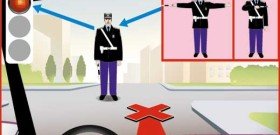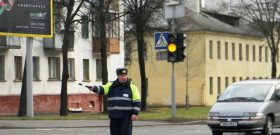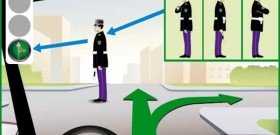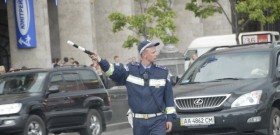Traffic controller - how to understand his signals?
Content
Today, we don’t meet the traffic controller as often as before, apparently because the traffic light system is well adjusted, computer controlled and practically does not fail. Therefore, many drivers are confused when they see this participant on the road, not always correctly interpreting his gestures. We will try to fill these gaps with some of our readers.
The traffic controller at the intersection - how not to get confused?
Why do we sometimes have to meet with the traffic controller in the age of high technology? Yes, technology sometimes fails us, but this rarely happens, let's say you are just unlucky to get to the time of a breakdown of one or another traffic light. We will also see a man in uniform with a striped staff at a time when an important guest, a high official or head of state, for example, is expected in the city. Then, even with a working traffic light, we will have to obey the black-and-white baton of the traffic controller.
The main thing we start our review with is a very important reminder that should focus your attention on further information. According to the 2013 traffic rules, the traffic controller is the highest priority indicator of the direction and order of movement in a problem area. That is, even with properly working traffic lights, you should focus only on his commands. Well, now we can proceed to the description of the regulation process itself.
In addition to a striped baton, a traffic police officer can give signs with his hands or with a disk with a red reflector. But these signs will be intuitive to every driver.
How to decipher other signs of the traffic controller?
Now let's analyze the gestures a little more complicated, although if your spatial imagination is in perfect order, then there will be no problems here either. The main sign, which is given many meanings by the rules of the road, is a traffic controller with his right hand extended forward. We will try to dot the "i" and in this matter, the same rule with the movement along the sleeves will help us.
We remember that a lowered hand also allows entry into it, just to make life easier for an employee, it can be lowered. Therefore, trackless transport can move to the left hand, and move in all directions. After all, the elongated right allows you to turn left and leave it, bypassing the possibility of stumbling on your back. We can move straight and to the right because, again, we do not disturb the calmness of the back of the traffic controller. But the tram is allowed to move only to the left, this is one of the few cases when rail transport has less priority.


Watch this video on YouTube
From the side of the chest, that is, entering the right hand, we can only move to the right, since there is an exit through the left hand, albeit lowered. We will not be able to move in any other direction from this position. But no one can move from the side of the right side and back, because these are barriers familiar to us - an outstretched arm and back, which look like impregnable walls. Pedestrians in this position of the traffic controller can only move along the back, while he is driving cars there, people quietly, without distracting his attention, retreat from one bank to another.
Traffic officer - simple gestures
Here you are carelessly driving through an overloaded city, periodically standing idle in small traffic jams, and then you can see the traffic controller at the intersection on the horizon. You should not panic, let alone repeat the driving technique of neighboring cars, they can sometimes be wrong, if only because the drivers have forgotten the rules, or maybe they didn’t know them at all. Understanding the gestures is not so difficult, especially remembering this hint: you need to drive in and out through the sleeve, you can’t ride on your back and chest. Let's try to understand what this means, and start with the simplest and most obvious positions of the traffic controller.
First of all, we note that the raised hand prohibits any movement of all vehicles. If, when moving the wand up, you find yourself in the middle of the intersection, then you must complete the maneuver. Also a simple gesture in which you do not need to visually evaluate the complex geometry of movement is the position with arms outstretched to the sides. The gesture with both arms lowered is interpreted similarly, because sometimes it is difficult to hold hands apart for a long time.
Such signs of the traffic controller mean that we can go along the body in any direction, so long as the path does not rest against the back or chest. Namely, we can enter the arm and move straight to exit the other arm, or turn right, but not left, so we hit the "impregnable wall" - the back, chest or outstretched arm. Pedestrians can move freely along the body from hand to hand. Trams have limited freedom, they can only move straight from hand to hand, without the right to turn.


Watch this video on YouTube








One comment
Raiva
Stupid Russians.